Computer Bismarck: A Retrospective of the First Serious War-game for the Personal Computer.
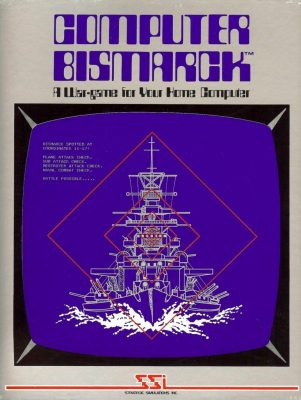 “In May of 1941 the war had just begun, The Germans had the biggest ship that had the biggest guns
“In May of 1941 the war had just begun, The Germans had the biggest ship that had the biggest guns
The Bismarck was the fastest ship that ever sailed the sea, On her decks were guns as big as steers and shells as big as trees”
Sink the Bismarck by Johnny Horton and Tillman Franks
By Patrick S. Baker
Computer Bismarck was developed and published by Strategic Simulations, Inc. (SSI) and is considered the first serious war game published for what was then called micro-computers and are now called personal computers, or PCs. Prior to Bismarck’s release computer video games had largely been arcade-style games; in home versions of Space Invaders or Pac-man, etc.
Released in February 1980 for the TRS-80 and the Apple II. The game was developed by Joel Billings and John Lyons and written in BASIC computer language. Rather than come up with a design from scratch, the two developers liberally “borrowed” (some would say lifted directly) from Avalon Hill’s (AH) board game, Bismarck. Noting the similarities of SSI’s Computer Bismarck, as well as other SSI titles, to their various board games, Avalon Hill took SSI to court in 1983. In 1984 the companies settled out of court, with SSI reportedly paying AH $30,000 dollars.
For Computer Bismarck, SSI was determined to produce a quality product. The game came with a typeset rule book, reference cards, plastic-coated maps, and grease pencils. All this came in a sturdy box with professional cover art. Before Computer Bismarck, most computer games were packed in zipper storage bags, aka “Ziploc” bags. SSI advertised the Computer Bismarck as the “$2,160 Wargame.” That was $60 dollars for the actual game and $2,100 dollars for the computer system. That is nearly $8,000 dollars today.
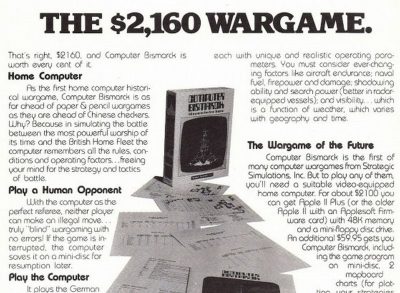 The computer game and the board game were both based on Operation Rheinübung (“Exercise Rhine”) conducted by the Nazi Kriegsmarine in May 1941. The plan for Rheinübung was to have the battleship Bismarck, and heavy cruiser Prinz Eugen, slip into the Atlantic and raid Allied convoys coming from North America to Britain. Once it was discovered that the two German ships were out to sea, much of the British Home Fleet sortied to intercept and sink them.
The computer game and the board game were both based on Operation Rheinübung (“Exercise Rhine”) conducted by the Nazi Kriegsmarine in May 1941. The plan for Rheinübung was to have the battleship Bismarck, and heavy cruiser Prinz Eugen, slip into the Atlantic and raid Allied convoys coming from North America to Britain. Once it was discovered that the two German ships were out to sea, much of the British Home Fleet sortied to intercept and sink them.
On 24 May 1941, Bismarck and Prinz Eugene made contact with HMS Hood, a battle-cruiser, and HMS Prince of Wales, a battleship, in the Denmark Straits. In a brief and furious battle, Bismarck sank Hood and badly damaged Prince of Wales, which had to break off the action. Bismarck was also hit; the most serious damage to her was a hit on a fuel bunker causing a severe fuel-oil leak. The damage was bad enough that Bismarck had to break off its mission and run for Nazi-occupied France with the British in hot pursuit.
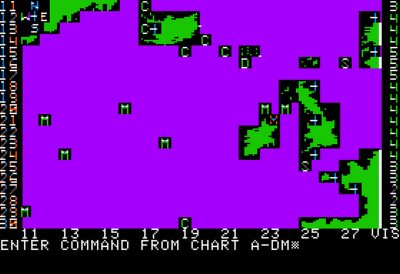 Computer Bismarck was first conceived as a simplified “fox and the hounds” game with Bismarck being the fox and the British Navy being the hounds. The game was turn-based with a human player controlling the British forces, and either a second human player or the game’s Artificial Intelligence (named “Otto von Computer”), controlling the German forces. The game came with six scenarios, two solo, and four two-player. The action took place on a map of the North Atlantic, which was colored a “monstrously magenta.”
Computer Bismarck was first conceived as a simplified “fox and the hounds” game with Bismarck being the fox and the British Navy being the hounds. The game was turn-based with a human player controlling the British forces, and either a second human player or the game’s Artificial Intelligence (named “Otto von Computer”), controlling the German forces. The game came with six scenarios, two solo, and four two-player. The action took place on a map of the North Atlantic, which was colored a “monstrously magenta.”
English alphabet letters denoted the various naval and air units and facilities, such as airfields and ports. The various units had different capabilities and statistics which established their game-play factors, such as firepower and mobility. Turns were divided into phases, and players alternated giving orders their respective units. Also, during the phases, the players received updates on status changes, unit movement, and battles. Players earned points by destroying their opponent’s units. After Bismarck is sunk, or a certain number of turns had taken place, the game ended. Victory was determined by the number of points earned by each player.
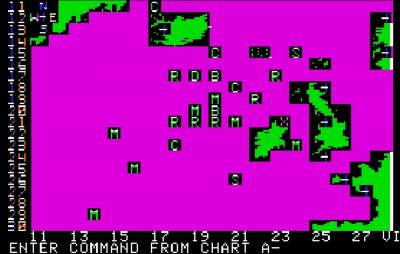 Reviews were mixed. BYTE called the game “a milestone” in the development of commercial war games. The reviewer approved of the quality of the documentation and the option to play solely against the computer but disapproved of the game’s mechanics. Ultimately the reviewer felt more could have been done with the possibles that the micro-computer offered in gameplay, rather than so closely replicating the board game.
Reviews were mixed. BYTE called the game “a milestone” in the development of commercial war games. The reviewer approved of the quality of the documentation and the option to play solely against the computer but disapproved of the game’s mechanics. Ultimately the reviewer felt more could have been done with the possibles that the micro-computer offered in gameplay, rather than so closely replicating the board game.
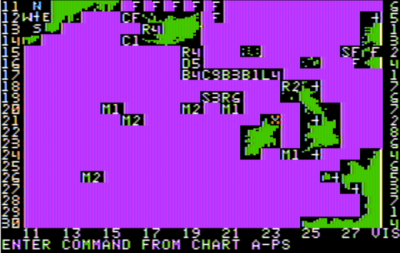 The reviewer from Moves also gave a mixed appraisal, he called the game both “engrossing” and “frustrating”. He noted it took “between two and four hours” to complete a single game. But considered the game worth playing: “if you had the time and the patience.”
The reviewer from Moves also gave a mixed appraisal, he called the game both “engrossing” and “frustrating”. He noted it took “between two and four hours” to complete a single game. But considered the game worth playing: “if you had the time and the patience.”
The Creative Computing review commended the AI and the fog of war aspects of the game but thought the level of detail might be too much to handle for the average player. Still, he said that for players ready for the challenge he “enthusiastically” recommended the game
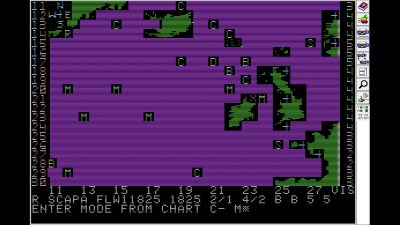 One very positive review came from The Space Gamer magazine which called Computer Bismarck “superb” and praised the graphics. Another rave review came from Popular Mechanics which called the game “fantastic” and compared it to a Pentagon war room for its level of detail.
One very positive review came from The Space Gamer magazine which called Computer Bismarck “superb” and praised the graphics. Another rave review came from Popular Mechanics which called the game “fantastic” and compared it to a Pentagon war room for its level of detail.
In 1982, SSI released Pursuit of the Graf Spee using a revised version of Computer Bismarck’s core systems. Then in 1987, SSI published its Classics that included Computer Bismarck and other titles for a much-reduced price.
Peter Perla of the Center for Naval Analyses in his 1990 book, The Art of Wargaming stated that SSI success came straight from such serious wargames and cited Computer Bismarck specifically. Certainly, the game’s brisk sales contributed to SSI’s business success and helped to cement serious war games as an important and profitable part of the video game market.
Patrick S. Baker is a former US Army Field Artillery officer and retired Department of Defense employee. He has degrees in History, Political Science, and Education. He has been writing history, game reviews, and science-fiction professionally since 2013. Some of his other work can be found at Sirius Science Fiction, Sci-Phi Journal, Armchair General, and Historynet.com
Sources:
BYTE Magazine, (December 1980). “Computer Bismarck”.
Computer Gaming World, (March 1988). “Titans of the Computer Gaming World.”
Creative Computing, (August 1980). “Computer Bismarck“.
High Score!: The Illustrated History of Electronic Games (New York: McGraw-Hill/Osbourne 2003).
Moves. (April, 1981) “Computer Bismarck”
Perla, Peter P. The Art of Wargaming (Annapolis, MD: Naval Institute Press. 1990)
Popular Mechanics, (August 1980). “PM Electronics Monitor: Have your own war room”.
Rockpapershotgun.com, (Oct. 2016) The Flare Path: In The Denmark Strait: Remembering Computer Bismarck
Space Gamer, The., (July 1980). “Capsule Reviews”.
